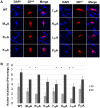Residues within the Foot-and-Mouth Disease Virus 3Dpol Nuclear Localization Signal Affect Polymerase Fidelity
- PMID: 32581111
- PMCID: PMC7431809
- DOI: 10.1128/JVI.00833-20
Residues within the Foot-and-Mouth Disease Virus 3Dpol Nuclear Localization Signal Affect Polymerase Fidelity
Abstract
Many RNA viruses encode a proof-reading deficient, low-fidelity RNA-dependent polymerase (RdRp), which generates genetically diverse populations that can adapt to changing environments and thwart antiviral therapies. 3Dpol, the RdRp of the foot-and-mouth disease virus (FMDV), is responsible for replication of viral genomes. The 3Dpol N terminus encodes a nuclear localization signal (NLS) sequence,MRKTKLAPT, important for import of the protein to host nucleus. Previous studies showed that substitutions at residues 18 and 20 of the NLS are defective in proper incorporation of nucleotides and RNA binding. Here, we use a systematic alanine scanning mutagenesis approach to understand the role of individual residues of the NLS in nuclear localization and nucleotide incorporation activities of 3Dpol We identify two residues of 3Dpol NLS, T19 and L21, that are important for the maintenance of enzyme fidelity. The 3Dpol NLS alanine substitutions of T19 and L21 results in aberrant incorporation of nucleoside analogs, conferring a low fidelity phenotype of the enzyme. A molecular dynamics simulation of RNA- and mutagen (RTP)-bound 3Dpol revealed that the T19 residue participates in a hydrogen bond network, including D165 in motif F and R416 at the C terminus of the FMDV 3Dpol and RNA template-primer. Based on these findings and previous studies, we conclude that at least the first six residues of theMRKTKLAPT sequence motif play a vital role in the maintenance of faithful RNA synthesis activity (fidelity) of FMDV 3Dpol, suggesting that the role of the NLS motif in similar viral polymerases needs to be revisited.IMPORTANCE In this study, we employed genetic and molecular dynamics approaches to analyze the role of individual amino acids of the FMDV 3Dpol nuclear localization signal (NLS). The NLS residues were mutated to alanine using a type A full-genome cDNA clone, and the virus progeny was analyzed for defects in growth and in competition with the parental virus. We identified two mutants in 3Dpol, T19A and L21A, that exhibited high rate of mutation, were sensitive to nucleotide analogs, and displayed reduced replicative fitness compared to the parental virus. Using molecular dynamics simulation, we demonstrated that residues T19 and L21 played a role in the structural configuration of the interaction network at the 3Dpol palm subdomain. Cumulatively, our data suggest that the T19 and L21 3Dpol amino acids are important for maintaining the fidelity of the FMDV polymerase and ensuring faithful replication of the FMDV genome.
Keywords: 3Dpol; FMDV; RNA-dependent RNA polymerase fidelity; enzyme nuclear localization signal; foot-and-mouth disease virus; picornavirus.
This is a work of the U.S. Government and is not subject to copyright protection in the United States. Foreign copyrights may apply.
Figures






Similar articles
-
Attenuation of Foot-and-Mouth Disease Virus by Engineered Viral Polymerase Fidelity.J Virol. 2017 Jul 12;91(15):e00081-17. doi: 10.1128/JVI.00081-17. Print 2017 Aug 1. J Virol. 2017. PMID: 28515297 Free PMC article.
-
Multifunctionality of a picornavirus polymerase domain: nuclear localization signal and nucleotide recognition.J Virol. 2015 Jul;89(13):6848-59. doi: 10.1128/JVI.03283-14. Epub 2015 Apr 22. J Virol. 2015. PMID: 25903341 Free PMC article.
-
Contribution of a Multifunctional Polymerase Region of Foot-and-Mouth Disease Virus to Lethal Mutagenesis.J Virol. 2018 Sep 26;92(20):e01119-18. doi: 10.1128/JVI.01119-18. Print 2018 Oct 15. J Virol. 2018. PMID: 30068642 Free PMC article.
-
The multiple roles of viral 3Dpol protein in picornavirus infections.Virulence. 2024 Dec;15(1):2333562. doi: 10.1080/21505594.2024.2333562. Epub 2024 Apr 15. Virulence. 2024. PMID: 38622757 Free PMC article. Review.
-
Structural insights into replication initiation and elongation processes by the FMDV RNA-dependent RNA polymerase.Curr Opin Struct Biol. 2009 Dec;19(6):752-8. doi: 10.1016/j.sbi.2009.10.016. Epub 2009 Nov 13. Curr Opin Struct Biol. 2009. PMID: 19914060 Review.
Cited by
-
Multiple functions of the nonstructural protein 3D in picornavirus infection.Front Immunol. 2024 Apr 2;15:1365521. doi: 10.3389/fimmu.2024.1365521. eCollection 2024. Front Immunol. 2024. PMID: 38629064 Free PMC article. Review.
-
Molecular characterization of VP1 gene during the foot and mouth disease virus outbreak in East Java, Indonesia, in 2022.Vet World. 2024 Nov;17(11):2469-2476. doi: 10.14202/vetworld.2024.2469-2476. Epub 2024 Nov 7. Vet World. 2024. PMID: 39829655 Free PMC article.
References
Publication types
MeSH terms
Substances
LinkOut - more resources
Full Text Sources
Research Materials

